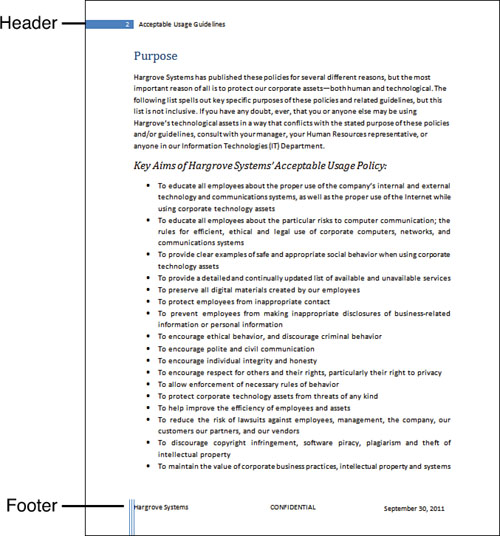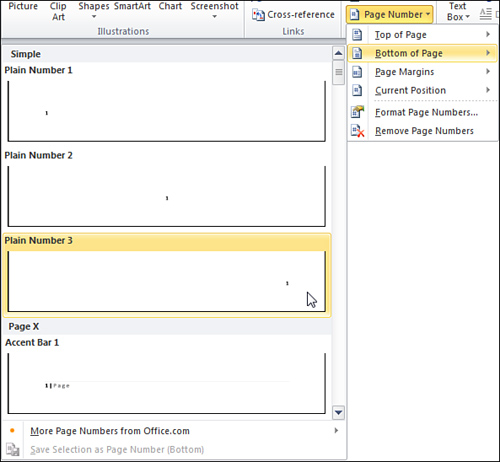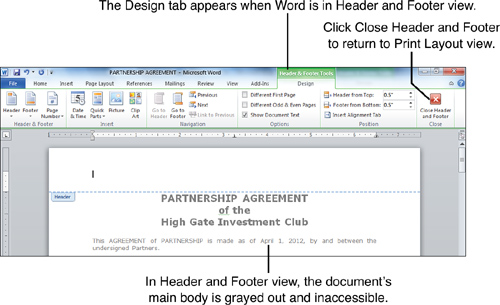Headers and footers provide the reader with important
information about your document, and make it easier to navigate a
document that is long or divided into multiple sections.
You can think of headers and
footers as design elements in a document because they reside in the
pages’ margins, and because you can format them differently than the
rest of a document to make them “pop.” But headers and footers are also
informational elements that can help guide the reader through a long
document by providing page numbers, section titles, and other facts
about the document.
Understanding Headers, Footers, and Field Codes
A header is a line or two of text (sometimes with graphics) that occupies the top margin of a page. A footer is exactly the same thing but appears in the page’s bottom margin. Figure 1
shows a page with both a header and a footer. Headers and footers are
not considered part of a document’s normal text, such as headings or
paragraphs of body text. Instead, Word treats headers and footers as
special elements of a document because they must appear in exactly the
same place and with the same content on every page (unless you decide to
use different headers and/or footers on different pages of the
document, as we discuss later).

Typically, a header or
footer is formatted with a centered tab stop in the middle of the page,
and a right-aligned tab stop at or near the right margin. These tabs let
you insert text in three places (left-aligned, center-aligned, and
right-aligned):

But a header or footer can
be even simpler than this. For example, in a multiple-page document,
there may be just a footer that displays only the current page number.
On the other hand, headers and
footers can be design elements, containing fancy fonts, lines or
borders, shading, graphics, and other items. You can format a header or
footer with fonts, font sizes, colors, and many of the same tools you
use to format a document’s body text. You just don’t have as much space
to work in.
Headers and footers often include little pieces of programming magic, called field codes.
Field codes can display many kinds of information (such as the current
page number and total number of pages, date, or time), which they draw
either from your computer or from the document itself. When you tell
Word to display page numbers in a footer, for example, it inserts a
“Page” field code at the insertion point’s location in the footer; the
field code automatically updates on each page to display the right
number. Word offers dozens of predefined field codes, several of which
are suitable for using in a header or footer.
Inserting Preformatted Page Numbers
A simple header or footer
might display only the current page number. Word has a special tool for
this: the Page Number button. The Page Number button lets you choose
from a variety of preformatted numbers, with different fonts, colors,
and alignments. These options free you from formatting your page numbers
manually.
|
Why can’t you just type a page
number in the footer area and forget about it? Good question! Here’s a
good answer: Because Word will just repeat the number you typed on every
page. If you want each page to display its actual number, you need to
use the Page Number button or insert a complete header or footer that
contains the page number. That way, Word will insert a Page field code
into your header or footer; the field code has to be there if you want
your pages to be numbered automatically.
|
Inserting and Formatting Page Numbers
You can place a page number in
either the page’s header or footer area in the right or left margin or
at the insertion point’s location. You just tell Word where to place the
page number and which format to use. Here’s how:
1. | In an open document that does not already have page numbers, click the Insert tab.
|
2. | In
the Header & Footer group, click Page Number. A drop-down menu
appears, showing different options for inserting a page number.
|
3. | Click one of the following items on the menu:
- Top of Page: Inserts a Page field code in the document’s header area.
- Bottom of Page: Inserts a Page field code in the document’s footer area.
- Page Margins: Inserts a Page field code in either the right or left margin, either high or low on the page.
- Current Position: Inserts a Page field code at the insertion point’s location, wherever it may be in the document.
|
4. | When
you click any of these options, a menu pops out and displays several
preformatted page numbers that can be inserted at that position on the
page. Figure 2 shows the menu that appears when the Bottom of Page option is clicked.

|
5. | Scroll
through the menu to find a page number you like; then click it. Word
inserts the formatted Page field code at the appropriate location. Figure 3 shows the result after adding the page number to the bottom-right of the page.

|
In Figure 3, notice that the footer area is divided from the document’s body by a dashed line that displays the Footer tag. Figure 4
shows the document’s header area, along with the Header & Footer
Tools Design tab, which appears whenever you work with a header or
footer.

Page numbers, headers, and
footers are visible only in Print Layout view. When the insertion point
is located in the header or footer area of a page, Word switches to
Header and Footer view. In this view, you can access and edit a header
or footer, but the document body is grayed and cannot be accessed until
you exit Header and Footer view.